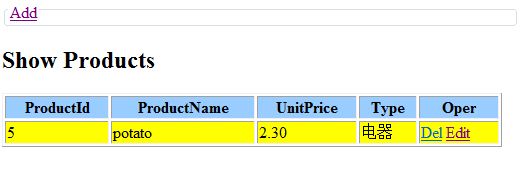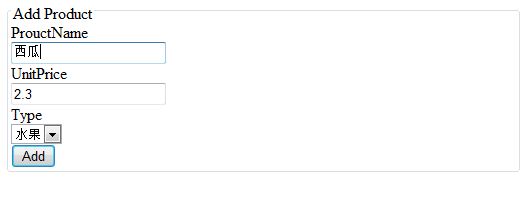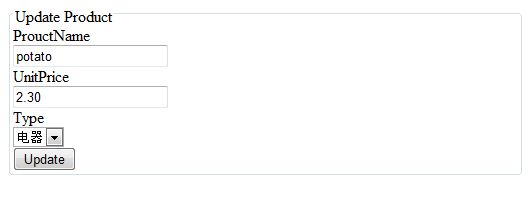| 1,功能描述 |
一个基于标准的ASP.NET MVC2.0 + ADO.NET Entity(实体类)+Oracle数据库的一个项目.主要功能有:用户登录,产品的操作,商品展示,添加产品,修改商品,删除商品.
| 2,技术与环境 |
|
操作系统: |
windows |
开发语言: |
C# |
|
开发框架: |
ASP.NET MVC 2.0 |
数据库: |
Oracle |
|
开发软件: |
Microsoft Visual Studio 2010 |
||
|
开发技术 |
ASP.NET MVC +ADO.NET Entity |
||
|
项目组长: |
yuanbo |
成员: |
null |
| 3,数据库设计 |
数据关系图:
3.1,基本数据库
3.1.1 sql-mvc-basic.sql
 View Code
View Code
Microsoft Windows XP [版本 5.1.2600] (C) 版权所有 1985-2001 Microsoft Corp. C:\Documents and Settings\Administrator>sqlplus SQL*Plus: Release 10.2.0.1.0 - Production on 星期五 3月 1 14:44:29 2013 Copyright (c) 1982, 2005, Oracle. All rights reserved. 请输入用户名: system/m123 连接到: Oracle Database 10g Express Edition Release 10.2.0.1.0 - Production SQL> --1,展示当前用户 SQL> show user; USER 为 "SYSTEM" SQL> --2,创建"sunshine"用户并给密码"m123" SQL> create user sunshine identified by m123; 用户已创建。 SQL> --3,授予该用户“链接”和“资源”俩个权限 SQL> grant connect,resource to sunshine; 授权成功。 SQL> --4,切换到sunshine用户 SQL> connect sunshine/m123; 已连接。 SQL> --5,展示当前用户 SQL> show user; USER 为 "SUNSHINE" SQL> --6,创建"用户表" SQL> create table Users 2 ( 3 username varchar(100) primary key, 4 userpass varchar(100) not null 5 ); 表已创建。 SQL> --7,展示表结构 SQL> desc Users; 名称 是否为空? 类型 ----------------------------------------- -------- ---------------------------- USERNAME NOT NULL VARCHAR2(100) USERPASS NOT NULL VARCHAR2(100) SQL> --8,向"用户表"插入一条测试数据 SQL> insert into Users(username,userpass) values('yb','m123'); 已创建 1 行。 SQL> --9,创建"产品表" SQL> create table Product 2 ( 3 productId int primary key, 4 productName varchar(100), 5 unitprice number(6,2), 6 type varchar(100) check(type in('电器','水果')) 7 ); 表已创建。 SQL> --10,为产品表创建一个序列 SQL> create sequence seqProduct start with 1000 increment by 1; 序列已创建。 SQL> --11,向"产品表"插入一个数据 SQL> insert into Product(productId,productName,unitprice,type) values(seqProduct .nextval,'洗衣机','2000','电器'); 已创建 1 行。 SQL> --12,查看产品表数据 SQL> select * from Product; PRODUCTID ---------- PRODUCTNAME -------------------------------------------------------------------------------- UNITPRICE ---------- TYPE -------------------------------------------------------------------------------- 1000 洗衣机 2000 电器 SQL> --13,提交以上操作 SQL> commit; 提交完成。 SQL>
3.2,插入测试数据
无,在3.1.1已插入测试数据。
3.3,操作表步骤
3.3.1 1, Users.sql
 View Code
View Code
-- ============================================= -- ylb_menu: MVC测试数据库 -- table: 1,Users -- remark:对用户表的操作与步骤 -- author: yuanbo -- pubdate:16:05 2013-03-01 -- ============================================= connect sunshine/m123 go -- ============================================= -- ylb_test: 1,向"Users"表插入测试数据 -- remark: 测试数据 -- ============================================= insert into Users(username,userpass) values('yb','m123') go -- ============================================= -- ylb: 1,Login -- remark: 用户登录 -- ============================================= select COUNT(*) from Users where username='yb' and userpass='m123'
3.3.2 2, Product.sql
 View Code
View Code
-- ============================================= -- ylb_menu: MVC测试数据库 -- table: 1,Products -- remark:对产品表的操作与步骤 -- author: yuanbo -- pubdate:16:05 2013-03-01 -- ============================================= connect sunshine/m123 go -- ============================================= -- ylb_test: 1,向"Users"表插入测试数据 -- remark: 测试数据 -- ============================================= go -- ============================================= -- ylb: 1,GetAll -- remark: 获取所有产品,并以productId降序排列 -- ============================================= select productId,productName,unitPrice,type from Product order by productId desc go -- ============================================= -- ylb: 2,Add -- remark: 添加一个产品 -- field: productName,unitPrice,type -- ============================================= select productName,unitPrice,type from Product go insert into Product(productId,productName,unitPrice,type) values(seqProduct.nextval,,,) go -- ============================================= -- ylb: 3,GetModel -- remark: 获得一个实体对象,根据productId -- ============================================= select productId,productName,unitPrice,type from Product where productId=0 go -- ============================================= -- ylb: 4,Update -- remark: 修改一条信息 ,根据productId -- ============================================= update Product set productName='yb',unitPrice='2.3',type='电器' where productId=0 go -- ============================================= -- ylb: 5,Delete -- remark: 删除一条信息,根据productId -- ============================================= delete Product where productId=0
| 4,功能截图 |
4.1,前台
4.1.1 用户登录(/Views/Account/Login.aspx)
4.1.2 商品展示(/Views/Product/Index.aspx)
4.1.3 添加商品(/Views/Product/Create.aspx)
4.1.4 修改商品(/Views/Product/Edit.aspx)
4.1.5 删除商品(/Views/Product/Index.aspx)

4.2,后台
无后台。
| 5,代码分析 |
5.1.1 [只有一个示例展示,更多请下载百度文库示例案例…] 即,/Product的商品展示为例,讲解MVC和Entity运用
5.1.1_P: MVC为什么要引入实体类,引入之后有什么好处?
5.1.1_A: 说道好处,采用MVC架构优点是:“分离是最大的优点。”,我们知道了好处了,具体体现在哪里表现啊?
a)有利于程序员和美工的分工合作更加清晰,真正地实现互不干扰。b)减小程序员的工作量,主要体现在在控制器和视图的数据转换,强转。
5.1.1.1_M_Info_1, /Models/ProductInfo.cs
 View Code
View Code
using System; using System.Collections.Generic; using System.Linq; using System.Web; namespace Mvc1.Models { public class ProductInfo { public int? ProductId { get; set; } public string ProductName { get; set; } public decimal? UnitPrice { get; set; } public string Type { get; set; } } }
5.1.1.1_M_Info_2, /Models/BaseList.cs
 View Code
View Code
using System; using System.Collections.Generic; using System.Linq; using System.Web; namespace Mvc1.Models { public class BaseList { /// <summary> /// 产品实体类集合 /// </summary> public IList<ProductInfo> Prods { get; set; } } }
5.1.1.1_M_Oper /Models/Product.cs
 View Code
View Code
using System; using System.Collections.Generic; using System.Linq; using System.Web; using System.Data.OracleClient; namespace Mvc1.Models { public class Product { /// <summary> /// ylb: 1,GetAll /// remark: 获取所有产品,并以productId降序排列 /// </summary> /// <returns></returns> public IList<ProductInfo> GetAll() { IList<ProductInfo> dals = new List<ProductInfo>(); string sql = "select productId,productName,unitPrice,type from Product order by productId desc"; OracleConnection conn = new DBConnection().Conn; OracleCommand com = conn.CreateCommand(); com.CommandText = sql; conn.Open(); try { OracleDataReader sdr = com.ExecuteReader(); while (sdr.Read()) { ProductInfo dal = new ProductInfo() { ProductId = sdr.GetInt32(0), ProductName = sdr.GetString(1), UnitPrice = sdr.GetDecimal(2), Type = sdr.GetString(3) }; dals.Add(dal); } } finally { conn.Close(); } return dals; } /// <summary> /// ylb: 2,Add /// remark: 添加一个产品 /// field: productName,unitPrice,type /// </summary> /// <param name="dal"></param> public void Add(ProductInfo dal) { string sql = "insert into Product(productId,productName,unitPrice,type) values(seqProduct.nextval,:productName,:unitPrice,:type)"; OracleConnection conn = new DBConnection().Conn; OracleCommand com = conn.CreateCommand(); com.Parameters.Add(new OracleParameter(":productName", dal.ProductName)); com.Parameters.Add(new OracleParameter(":unitPrice", dal.UnitPrice)); com.Parameters.Add(new OracleParameter(":type", dal.Type)); com.CommandText=sql; conn.Open(); try { com.ExecuteNonQuery(); } finally { conn.Close(); } } /// <summary> /// ylb: 3,GetModel /// remark: 获得一个实体对象,根据productId /// </summary> /// <param name="productId"></param> /// <returns></returns> public ProductInfo GetModel(int productId) { ProductInfo dal = null; string sql = "select productId,productName,unitPrice,type from Product where productId=:productId"; OracleConnection conn = new DBConnection().Conn; OracleCommand com = conn.CreateCommand(); com.Parameters.Add(new OracleParameter(":productId", productId)); com.CommandText = sql; conn.Open(); try { OracleDataReader sdr = com.ExecuteReader(); while (sdr.Read()) { dal = new ProductInfo() { ProductId = sdr.GetInt32(0), ProductName = sdr.GetString(1), UnitPrice = sdr.GetDecimal(2), Type = sdr.GetString(3) }; } } finally { conn.Close(); } return dal; } /// <summary> /// ylb: 4,Update /// remark: 修改一条信息 ,根据productId</summary> /// <param name="dal"></param> public void Update(ProductInfo dal) { string sql = "update Product set productName=:productName,unitPrice=:unitPrice,type=:type where productId=:productId"; OracleConnection conn = new DBConnection().Conn; OracleCommand com = conn.CreateCommand(); com.Parameters.Add(new OracleParameter(":productName", dal.ProductName)); com.Parameters.Add(new OracleParameter(":unitPrice", dal.UnitPrice)); com.Parameters.Add(new OracleParameter(":type", dal.Type)); com.Parameters.Add(new OracleParameter(":productId", dal.ProductId)); com.CommandText = sql; conn.Open(); try { com.ExecuteNonQuery(); } finally { conn.Close(); } } /// <summary> /// ylb: 5,Delete /// remark: 删除一条信息,根据productId /// </summary> /// <param name="productId"></param> public void Delete(int productId) { string sql = "delete Product where productId=:productId"; OracleConnection conn = new DBConnection().Conn; OracleCommand com = conn.CreateCommand(); com.Parameters.Add(new OracleParameter(":productId", productId)); com.CommandText = sql; conn.Open(); try { com.ExecuteNonQuery(); } finally { conn.Close(); } } } }
5.1.1.1_V /Views/Product/Index.aspx ylb_tip:字体加粗,字号加大的方是你要重点看的地方。
<%@ Page Language="C#" Inherits="System.Web.Mvc.ViewPage<Mvc1.Models.BaseList>" %> <%@Import Namespace="Mvc1.Models" %> <!DOCTYPE html PUBLIC "-//W3C//DTD XHTML 1.0 Transitional//EN" "http://www.w3.org/TR/xhtml1/DTD/xhtml1-transitional.dtd"> <html xmlns="http://www.w3.org/1999/xhtml" > <head runat="server"> <title>Index</title> <style type="text/css"> .style1 { background-color: #99CCFF; } .style2 { background-color: #FFFF00; } </style> </head> <body> <div> <fieldset> <legend> <a href="/Product/Create">Add</a> </legend> </fieldset> <h2>Show Products</h2> <table width="500" border="1"> <tr> <th class="style1">ProductId</th> <th class="style1">ProductName</th> <th class="style1">UnitPrice</th> <th class="style1">Type</th> <th class="style1">Oper</th> </tr> <% foreach (ProductInfo prod in Model.Prods) { %> <tr> <td class="style2"><%=prod.ProductId%></td> <td class="style2"><%=prod.ProductName%></td> <td class="style2"><%=prod.UnitPrice%></td> <td class="style2"><%=prod.Type%></td> <td class="style2"> <a href="<%=string.Format("/Product/Delete/{0}",prod.ProductId) %>">Del</a> <a href="<%=string.Format("/Product/Edit/{0}",prod.ProductId) %>">Edit</a> </td> </tr> <%} %> </table> </div> </body> </html>
5.1.1.1_C /Controllers/ProductController.cs
using System; using System.Collections.Generic; using System.Linq; using System.Web; using System.Web.Mvc; using Mvc1.Models; namespace Mvc1.Controllers { public class ProductController : Controller { // // GET: /Product/ public ActionResult Index() { BaseList baseList= new BaseList(); //创建实体类 baseList.Prods = new Product().GetAll(); //把产品集合付给实体类 return View(baseList); //带到视图 } } }
5.2,后台
无。
| 6,示例|讲解案例下载 |
谷歌开源代码下载:
http://code.google.com/p/ylbtechaspnetmvc/downloads/list
请单击“MVC+ADO.NET Entity(实体类)+Oracle”
百度网盘 http://pan.baidu.com/s/1i49zn73
请单击“MVC+ADO.NET Entity(实体类)+Oracle”
| 作者:ylbtech 出处:http://ylbtech.cnblogs.com/ 本文版权归作者和博客园共有,欢迎转载,但未经作者同意必须保留此段声明,且在文章页面明显位置给出原文连接,否则保留追究法律责任的权利。 |





